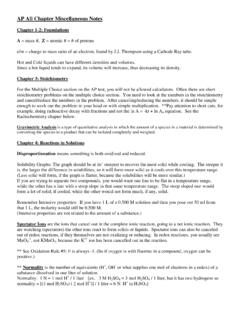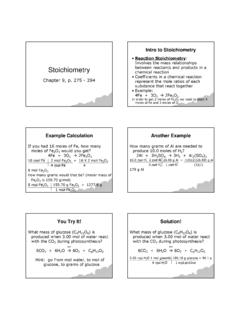Transcription of Chapter 3: Stoichiometry - Sailor Research Group HOME
1 Chem 6A Michael J. Sailor , UC San DiegoChapter 3: Stoichiometry1 Chem 6A Michael J. Sailor , UC San DiegoAnnouncements: Thursday (Sep 29) quiz: Bring student ID or we cannot accept your quiz! No notes , no calculators Covers chapters 1 and 2 Need to know your name, PID, and section #2 Chem 6A Michael J. Sailor , UC San Diego3 Chem 6A 2010 ( Sailor ) QUIZ Name: Student ID Number: Section Number: Some useful constants and relationships: Ideal gas constant: .K-1 = .K-1 Avogadro constant: x 1023 mole-1 Planck's constant = h = x 10-34 speed of light: x 108 m/s J = 1 1J = 1 atm = 760 Torr 1 eV = x 10-19 J E = -RHh/n2 RH = x 1015 Hz C2 = second radiation constant = x 10-2 !
2 Emitted power (W)Surface area (m2)=(constant)T4 ! T"max=15C2 ! E=hc" Cover page of Thursday s quizChem 6A 2010 ( Sailor ) Periodic Table QUIZ Name: Student ID Number: Section Number: INSTRUCTIONS: Fill in the blanks with the chemical symbols for the elements. 1181221314151617345678910111213141516171 8345678910111219202122232425262728293031 3233343536373839404142434445464748495051 5253545556577273747576777879808182838485 868788 Chem 6A Michael J. Sailor , UC San DiegoThe Periodic Table of the Elements QUIZTHURS Oct 20 (front page)4 Chem 6A Michael J. Sailor , UC San DiegoThe Periodic Table of the Elements QUIZTHURS Oct 20 (back page)5 Provide the names of the following 20 elements totalhydrogenlithiu mfranciumplatinumsilverantimonyChem 6A Michael J.
3 Sailor , UC San Diego6 Problem: Mass-to-mass calculationsSince the bronze age (4000 ), copper metal has been produced by smelting, in which Cu2O ore is reduced with excess carbon (charcoal). How much copper can be produced from smelting of kg of pure Cu2O? a) 222 gb) 888 gc) 444 gd) 2252 ge) none of the aboveChem 6A Michael J. Sailor , UC San Diego7 Solution: Mass-to-mass calculations(1) The balanced equation for the reaction is: 2Cu2O + C 4Cu + CO2(2) Find out how many moles of Cu are there, then convert to grams Cu: = 888 g Cu1000 g Cu2 OMol Cu2O4 mol g g Cu2O2 mol Cu2O1 mol CuChem 6A Michael J.
4 Sailor , UC San Diego8 Problem: Limiting reactantIn the Haber process, hydrogen (H2) reacts with nitrogen (N2) in a reactor to make ammonia. The reactor is initially charged with 2 mol of H2 and 3 mol of N2 and the reaction is allowed to go to completion. Fill out the table below indicating the amounts of reactants and products present after the reaction is H2 + N2 2 NH3 Moles H2 Moles N2 Moles NH3 Chem 6A Michael J. Sailor , UC San Diego9 Solution: Limiting reactantThe reactor is initially charged with 2 mol of H2 and 3 mol of N2 Balanced equation: 3 H2 + N2 2 NH3If all 2 mol of H2 reacts, how many moles of N2 are needed?
5 Before reactionAfter reactionMoles H22 Moles N23 Moles NH30 Chem 6A Michael J. Sailor , UC San Diego10 Solution: Limiting reactantThe reactor is initially charged with 2 mol of H2 and 3 mol of N2 Balanced equation: 3 H2 + N2 2 NH3If all 2 mol of H2 reacts, how many moles of N2 are needed?We have 3 mole of N2, so N2 is in excess and H2 is limiting= 2/3 mol N2 neededChem 6A Michael J. Sailor , UC San Diego11 Solution: Limiting reactantThe reactor is initially charged with 2 mol of H2 and 3 mol of N2 and the reaction is allowed to go to equation: 3 H2 + N2 2 NH3 After reaction,Moles H2 = 2-2 = 0 Moles N2 = 3 - 2/3 = 7/3, or NH3 = 0 + 2 mol H22 mol NH33 mol H2= 4/3, or reactionWhat s used?
6 What s left?Moles H2220 Moles N232 6A Michael J. Sailor , UC San Diego12 Solution: Limiting reactantWhat if we chose to calculate it assuming the N2 is limiting?Balanced equation: 3 H2 + N2 2 NH3If all 3 mol of N2 reacts, how many moles of H2 are needed?Before reactionAfter reactionMoles H22 Moles N23 Moles NH30 Chem 6A Michael J. Sailor , UC San Diego13 Solution: Limiting reactantIf all 3 mol of N2 reacts, how many moles of H2 are needed?Balanced equation: 3 H2 + N2 2 NH3We only have 2 mole of H2, so H2 is limiting= 9 mol H2 neededChem 6A Michael J. Sailor , UC San DiegoChapter 3: Stoichiometry (cont)Chem 6A, Section D Sept 29, 201114 Chem 6A Michael J.
7 Sailor , UC San Diego15 Problem: Limiting reactantSince the bronze age (4000 ), copper metal has been produced by smelting, in which Cu2O ore is reduced with excess carbon (charcoal). How much copper can be produced from smelting of kg of pure Cu2O with 25 g of charcoal? Assume the byproduct of the reaction is CO2. a) 222 gb) 888 gc) 444 gd) 2252 ge) none of the aboveChem 6A Michael J. Sailor , UC San Diego16 Solution: Limiting reactantThe balanced equation for the reaction is: 2Cu2O + C 4Cu + CO2 Find out how many moles of Cu2O we have:1000 g Cu2 OMol g Cu2O1000 g Cu2 OMol Cu2O1 mol g Cu2O2 mol Cu2O= mol Cu2 Ohow many moles of C are needed:= mol CneededFind out how many moles of C we have:25 g CMol g C= mol CChem 6A Michael J.
8 Sailor , UC San Diego17 Solution: Limiting reactantWe have mol C. We need , so all of the C will be used up before all of the Cu2O has reacted. So C (carbon) is the limiting many moles of Cu will be produced using this much C?25 g CMol C4 mol g g C1 mol CMol Cu= 529 g CuChem 6A Michael J. Sailor , UC San Diego18 Problem: Combustion analysisCombustion analysis is carried out on g of a compound that contains only carbon, hydrogen, and oxygen. The masses of water and carbon dioxide produced are g and g, respectively. What is the empirical formula of the compound?
9 See problem from the bookChem 6A Michael J. Sailor , UC San Diego19 Solution: Combustion analysisLike excess-limiting reagent problem except the oxygen is never limiting:CxHyOz + xs O2 x CO2 + y/2 H2 OFigure out number of moles and mass of carbon, g CO21mol CO21 mole g CO21 mol CO2= moles moles g C1 mol C= g g H2O1mol H2O2 mole g H2O1 mol H2O= moles moles g H1 mol H= g HChem 6A Michael J. Sailor , UC San Diego20 Solution: Combustion analysisCxHyOz + xs O2 x CO2 + y/2 H2 OMass left over = - - = gmass CxHyOzmass Cmass HSo g is the mass of O (NOT O2) in the sample.
10 The number of moles of O g O1mol g O= mol 6A Michael J. Sailor , UC San Diego21 Solution: Combustion analysisCxHyOz + xs O2 x CO2 + y/2 H2 ODividing by the least common denominator (O in this case):So the empirical formula is C2H6 OChem 6A Michael J. Sailor , UC San Diego22 OHH105 2!-!+!+Water:Chem 6A Michael J. Sailor , UC San Diego23 Sodium Chloride (NaCl) CrystalUnit CellNa+Cl-Chem 6A Michael J. Sailor , UC San Diego24= Na+= Cl-= H2 OSoluteSolventDissolution of NaCl in waterion-dipole interactions replace ion-ion interactionsChem 6A Michael J. Sailor , UC San Diego25 Ethanol in waterdipole-dipole interactions: Like Dissolves Like Hydrogen BondsChem 6A Michael J.











